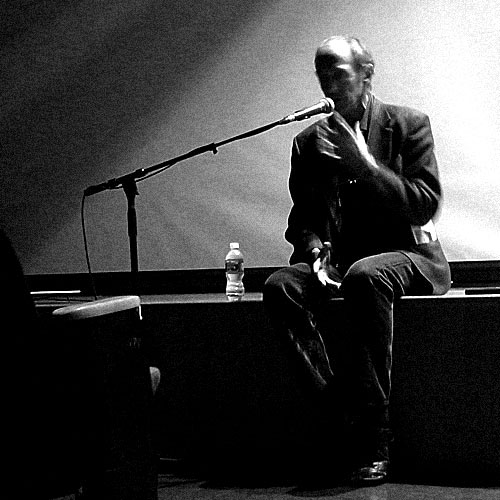It was a photographic version of the colorful phrase, drinking from the firehose. Thursday night I attended a lecture by Magnum photographer Paul Fusco and then Friday, an opening of a show by National Geographic photographer Cary Wolinsky, both events presented by the Photographic Resource Center.
Paul Fusco spoke softly but passionately to a packed BU auditorium where he discarded the podium and sat on the stage, insisting on near-total darkness so the images (projected from an authentic slide carousel) could be seen best.
First, Fusco showed images from his RFK Funeral Train project. In 1968 (a time, he noted, that was full of both hope and uncertainty, not unlike the present) he was assigned to photograph Bobby Kennedy’s funeral and boarded the train carrying RFK’s casket from New York to Washington. It turned out that nearly the entire route was lined with mourners, and Fusco photographed them from the train window. It’s an incredible slice of history and a collective portrait of the people of America at the time. Buy the book or at least look at the website.
Next, he showed work that has not yet found a publisher, a series he calls Chernobyl Legacy. The beauty of Fusco’s composition and use of light does little to make these pictures any easier to look at, but at the same time you can’t turn away. In Ukraine, Belarus and Russia, Fusco photographed the hospitalized and institutionalized childen and adults terribly damaged by the fallout from the 1986 nuclear accident. Fusco’s passion for looking this event unflinchingly in the face and sharing it with the world was evident and contagious.

Among others, I ran into Jason Liu, one of the artists in Hudson Street Gallery‘s current show, and David Strasburger, one of whose prints I bought at the PRC’s auction last month.
The next day, I attended the opening of the second exhibition of the MIT-PRC joint gallery space at MIT’s Center for Theoretical Physics. That’s 6-304 for your Institute types, just go to the end of the Infinite Corridor and go up to the third floor, you can’t miss it. Nor should you. A new space has been constructed by enclosing the courtyard of building six, and the design of the space, even without the excellent artwork, is both inspiring and livable. I wrote about the first exhibition in this space last year.
Cary Wolinsky showed work from two series: Sand House and Varanasi. In Sand House, he documents a colonial-era house in Namibia that has been invaded by the adjacent desert and filled halfway up with sand. You have to see this to fully understand the surreal beauty of it. (And you should also check in with Max Becher and Andrea Robbins on how surreal the German presence in Namibia can be) Varanasi is an Indian city on the Ganges and home to the fabric-dying industry documented in Wolinsky’s photos. It’s part of his wider ongoing interest in textiles and fabrics and a body of work called “Fabric of Life.”


Besides the PRC show of Wolinsky’s photos, the MIT CTP space also has art and photographs by Sol LeWitt, Ansel Adams, director emeritus Robert Jaffe, and others. Also don’t miss the LeWitt floor installation that you can see from the bridge to building 6C.


There’s ace photographologist Leslie K. Brown at left, setting the story straight on B&W films. Also present were PRC director Jim Fitts and Jason Landry, currently the PRC’s interim education manager. I was also lucky enough to see photographers John Chervinsky and Peter Vanderwarker, and one third of conceptual/political art trio Triiibe. The official opening of this show is next week, so check it out.

Thanks for the mention and pic!